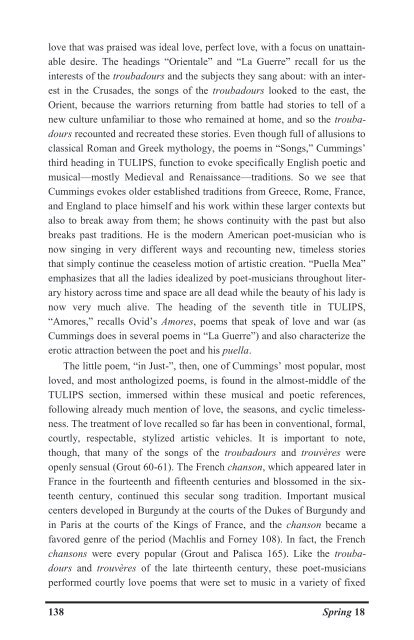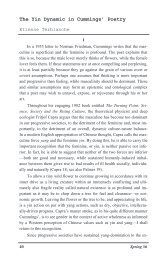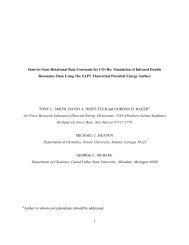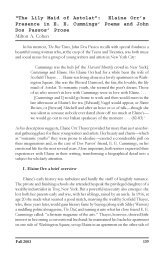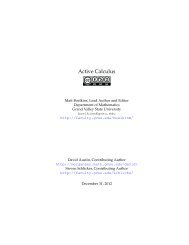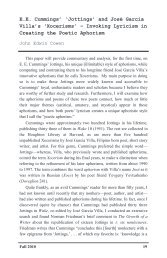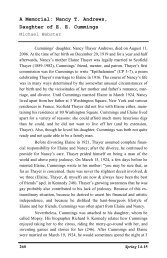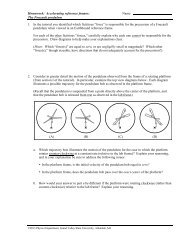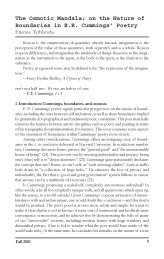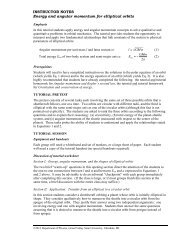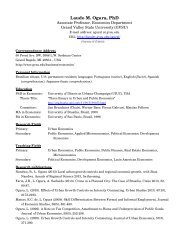The Aesthetics of EE Cummings' âin Just-â - Gvsu
The Aesthetics of EE Cummings' âin Just-â - Gvsu
The Aesthetics of EE Cummings' âin Just-â - Gvsu
- No tags were found...
You also want an ePaper? Increase the reach of your titles
YUMPU automatically turns print PDFs into web optimized ePapers that Google loves.
love that was praised was ideal love, perfect love, with a focus on unattainabledesire. <strong>The</strong> headings “Orientale” and “La Guerre” recall for us theinterests <strong>of</strong> the troubadours and the subjects they sang about: with an interestin the Crusades, the songs <strong>of</strong> the troubadours looked to the east, theOrient, because the warriors returning from battle had stories to tell <strong>of</strong> anew culture unfamiliar to those who remained at home, and so the troubadoursrecounted and recreated these stories. Even though full <strong>of</strong> allusions toclassical Roman and Greek mythology, the poems in “Songs,” Cummings’third heading in TULIPS, function to evoke specifically English poetic andmusical—mostly Medieval and Renaissance—traditions. So we see thatCummings evokes older established traditions from Greece, Rome, France,and England to place himself and his work within these larger contexts butalso to break away from them; he shows continuity with the past but alsobreaks past traditions. He is the modern American poet-musician who isnow singing in very different ways and recounting new, timeless storiesthat simply continue the ceaseless motion <strong>of</strong> artistic creation. “Puella Mea”emphasizes that all the ladies idealized by poet-musicians throughout literaryhistory across time and space are all dead while the beauty <strong>of</strong> his lady isnow very much alive. <strong>The</strong> heading <strong>of</strong> the seventh title in TULIPS,“Amores,” recalls Ovid’s Amores, poems that speak <strong>of</strong> love and war (asCummings does in several poems in “La Guerre”) and also characterize theerotic attraction between the poet and his puella.<strong>The</strong> little poem, “in <strong>Just</strong>-”, then, one <strong>of</strong> Cummings’ most popular, mostloved, and most anthologized poems, is found in the almost-middle <strong>of</strong> theTULIPS section, immersed within these musical and poetic references,following already much mention <strong>of</strong> love, the seasons, and cyclic timelessness.<strong>The</strong> treatment <strong>of</strong> love recalled so far has been in conventional, formal,courtly, respectable, stylized artistic vehicles. It is important to note,though, that many <strong>of</strong> the songs <strong>of</strong> the troubadours and trouvères wereopenly sensual (Grout 60-61). <strong>The</strong> French chanson, which appeared later inFrance in the fourteenth and fifteenth centuries and blossomed in the sixteenthcentury, continued this secular song tradition. Important musicalcenters developed in Burgundy at the courts <strong>of</strong> the Dukes <strong>of</strong> Burgundy andin Paris at the courts <strong>of</strong> the Kings <strong>of</strong> France, and the chanson became afavored genre <strong>of</strong> the period (Machlis and Forney 108). In fact, the Frenchchansons were every popular (Grout and Palisca 165). Like the troubadoursand trouvères <strong>of</strong> the late thirteenth century, these poet-musiciansperformed courtly love poems that were set to music in a variety <strong>of</strong> fixed138 Spring 18


